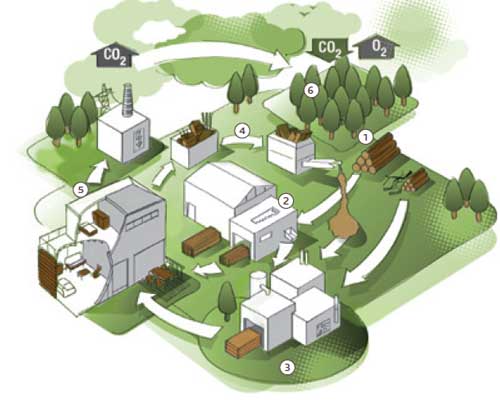- The life cycle of wood starts in the forest, where young trees take CO2 from the atmosphere. The carbon is stored in the wood through photosynthesis and oxygen is released into the atmosphere.
- Once the tree is fully grown, it is harvested and sawn into pieces. The larger parts are transported to the sawmill where they are processed into planks and beams. These planks and beams are used in numerous sectors, e.g. construction, furniture production, packaging, transport, etc. As such wood gives oxygen to the creativity of architects and designers, but to our economy too.
- The smaller branches and remainder of the processing in the mill are ground and compressed into wooden panels (boards, MDF, OSB) to be used primarily in the construction and furniture sectors.
- At the end of the life cycle of wooden products, non-recyclable wood residues and clean wood residues are separated. The clean wood residues are ground and recompressed into panels to start a second life. The cycle is closed. In many cases, several 'life cycles' are possible.
- Wood residues that can no longer be re-used or recycled may serve as a carbon-neutral fuel. It is only upon burning that wood releases the stored quantity of CO2. Modern incinerators transform non-recyclable wood into a 'green' kind of energy production, as an alternative to fossil fuels.
- Increasing wood consumption stimulates the forest-based industries to plant new trees and to sustainably manage the forests. In Europe for instance more trees are planted than are harvested.
THE LIFE CYCLE OF WOOD
Wood is a unique material
characterised by its ability to store carbon on the one hand and to produce oxygen on the other. The longer wood is used and re-used, the longer it stores carbon.

